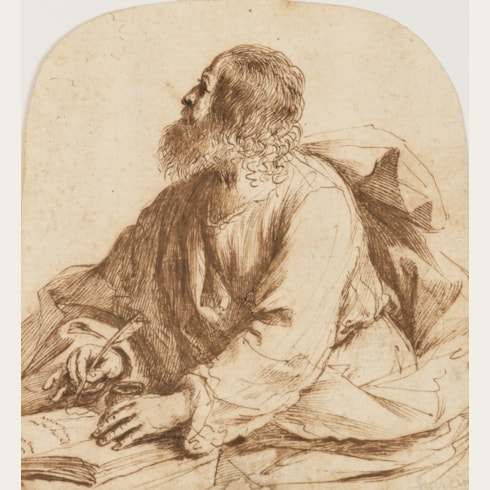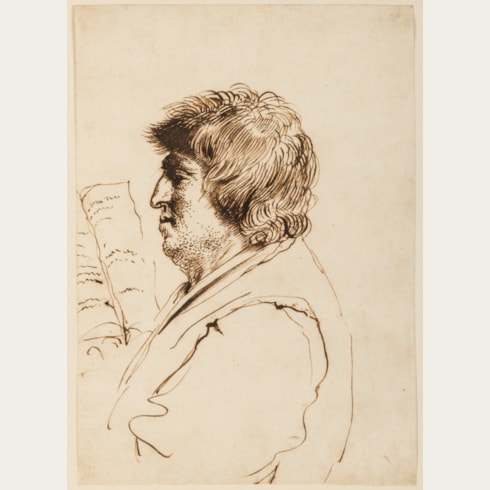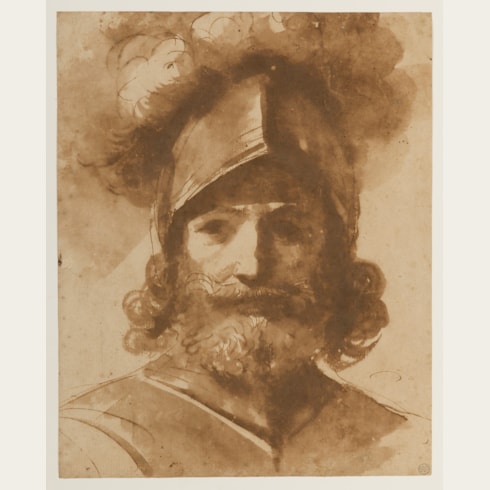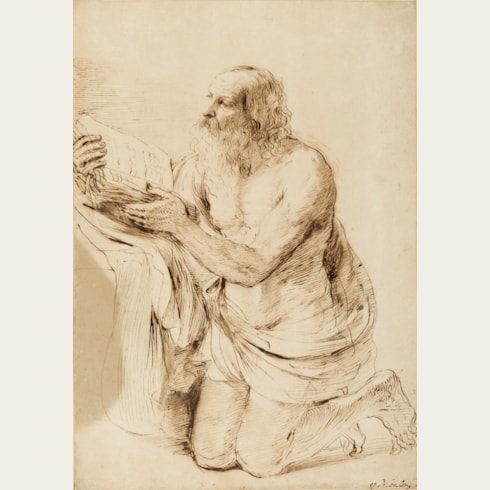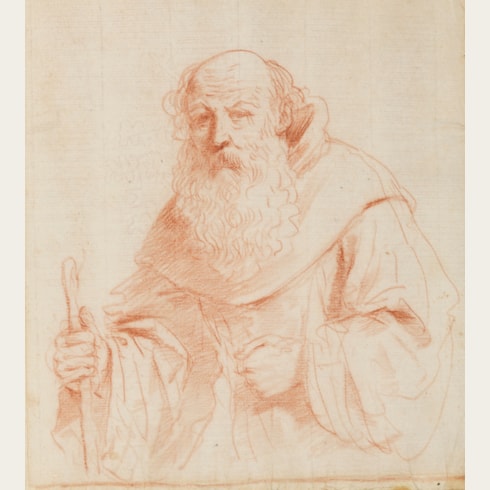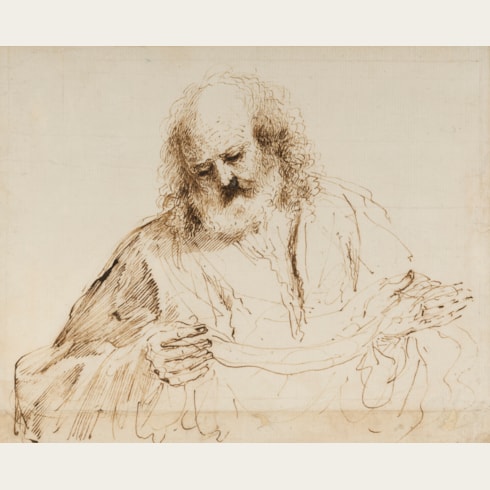Giovanni Francesco Barbieri GUERCINO
(Cento 1591 - Bologna 1666)
The Virgin of the Rosary with Saints Dominic and Catherine of Siena
Inscribed Guercino and numbered 7 on the verso.
401 x 267 mm. (15 3/4 x 10 1/2 in.)
Another pen and ink compositional drawing by Guercino for the Osimo altarpiece, formerly in the collection of Queen Christina of Sweden, is today in the Teyler Museum in Haarlem, while a third, drawn in red chalk and highly finished, is in the collection of the Dukes of Devonshire at Chatsworth. Among preparatory studies for individual figures in the painting is a pen and ink study for the Virgin in the Royal Collection at Windsor Castle and a pen drawing for two of the putti at the top right of the composition, which appeared at auction in London in 1974. Another study for the putti in the upper half of the altarpiece, drawn in red chalk, was formerly with Stephen Ongpin Fine Art and was recently acquired by the National Trust for The Vyne in Basingstoke, Hampshire. Finally, an untraced pen and ink drawing of the Virgin and Child, formerly in the collection of the Baron de Malaussena and sold at auction in Amsterdam in 1927, has been tentatively related to the Osimo canvas.
Some elements of the present sheet are also found in a slightly earlier altarpiece, with a different composition, of the same subject of The Virgin of the Rosary with Saints Dominic and Catherine of Siena, painted for the Compagnia del Rosario in Turin and placed in the church of San Domenico there in 1637. As is sometimes the case with Guercino’s compositional drawings, some confusion exists in determining which of the artist’s studies of this subject are related to one or the other of the two painted versions of The Virgin of the Rosary with Saints Dominic and Catherine of Siena; the Turin painting of 1637 or the Osimo altarpiece of a few years later. Compositional studies by Guercino for the Turin painting include a red chalk drawing in the British Museum and a pen and ink sheet in the Pierpont Morgan Library in New York. The pose of Saint Catherine in the present sheet, however, is close to that in the Morgan drawing, which has in the past been regarded as a preparatory study for the Osimo canvas.
A later copy of the present sheet by the 18th century Florentine engraver Francesco Bartolozzi (1727-1815), in the Albertina in Vienna, is part of a group of around fifteen copies of Guercino drawings by Bartolozzi in that collection. In the late 1750s and early 1760s, Bartolozzi seems to have had access to the large corpus of Guercino drawings in the Casa Gennari and made drawn copies after several of them; this would suggest the likelihood that the present sheet has a Casa Gennari provenance.
The present sheet bears the collector’s mark of the 20th century French art dealer Charles Férault (1877-1957), who began acquiring drawings from around 1910 onwards. Férault’s mark was applied only to those drawings - mostly by French and Italian artists - in his own collection, and not works held as stock.
Giovanni Francesco Barbieri, known as Il Guercino (‘the squinter’) because he was cross-eyed, was by the second decade of the 17th century one of the leading painters in the province of Emilia. Born in Cento, a small town between Bologna and Ferrara, Guercino was largely self-taught, although his early work was strongly influenced by the paintings of Ludovico Carracci. In 1617 he was summoned to Bologna by Alessandro Ludovisi, the Cardinal Archbishop of Bologna, and there painted a number of important altarpieces, typified by the Saint William Receiving the Monastic Habit, painted in 1620 and now in the Pinacoteca Nazionale in Bologna. When Ludovisi was elected Pope Gregory XV in 1621, Guercino was summoned to Rome to work for the pontiff and his nephew, Cardinal Ludovico Ludovisi. It was in Rome that Guercino painted some of his most celebrated works, notably the ceiling fresco of Aurora in the Casino Ludovisi and the large altarpiece of The Burial and Reception into Heaven of Saint Petronilla for an altar in Saint Peter’s. The papacy of Gregory XV was short-lived, however, and on the death of the Pope in 1623 Guercino returned to his native Cento. He remained working in Cento for twenty years, though he continued to receive commissions from patrons throughout Italy and beyond, and turned down offers of employment at the royal courts in London and Paris. Following the death of Guido Reni in 1642, Guercino moved his studio to Bologna, where he received commissions for religious pictures of the sort that Reni had specialized in, and soon inherited his position as the leading painter in the city.
Guercino was among the most prolific draughtsmen of the 17th century in Italy, and his preferred medium was pen and brown ink, although he also worked in red chalk, black chalk, and charcoal. He appears to have assiduously kept his drawings throughout his long career, and to have only parted with a few of them. Indeed, more drawings by him survive today than by any other Italian artist of the period. On his death in 1666 all of the numerous surviving sheets in his studio passed to his nephews and heirs, the painters Benedetto and Cesare Gennari, known as the ‘Casa Gennari’.
The drawings of Guercino, which include figural and compositional studies, landscapes, caricatures and genre scenes, have always been coveted by later collectors and connoisseurs. Indeed, the 18th century amateur Pierre-Jean Mariette noted of the artist that ‘Ce peintre a outre cela une plume tout-à-faite séduisante’. The largest extant group of drawings by Guercino is today in the Royal Collection at Windsor Castle; these were acquired from the Gennari family by King George III’s librarian, Richard Dalton, between about 1758 and 1764.
Provenance
Thence by descent to Carlo Gennari, Bologna and probably sold in the second half of the 18th century
Charles Férault, Paris and Biarritz (Lugt 2793a)
Private collection, France.
Literature




















